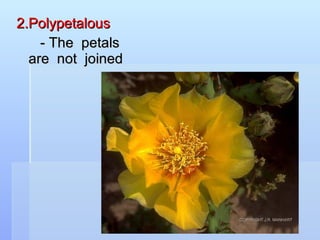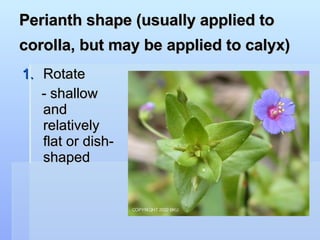Morphology Of The Flower Part 2
- 1. Types of flowers Part 2
- 2. According to corolla Symmetry Sympetalous – when petals are joined partly or wholly flower has connate petals. In such a corolla, one can distinguish different parts: - the floral tube, - the throat, and - the lobes
- 3. 2.Polypetalous - The petals are not joined
- 4. 3. Actinomorphic (corolla) This flower of is actinomorphic ( regular ). This means that the flower has a radial symmetry — it can be divided into two equal halves by two or more planes (5 here, shown by the yellow lines). These are further classified as funnel shaped, tubular shaped and campanulate (narrower than tubular, a bell like shape). Examples of families: Poppy family, cruciform and rose family are few notable examples of actinomorphic morphology.
- 6. Here is another example of actinomorphic flower. In this case the floral parts are numerous. This example is a water lily ( Nymphaea cultivar).
- 7. 4. Zygomorphic (irregular) flower has a bilateral symmetry — it can be divided in two equal halves by only one plane, as shown by the red line passing through this flower of Viola tricolor
- 8. Orchids have zygomorphic flowers . Here again, the flower can be cut into two symmetrical halves by only one plane, along the red line .
- 9. Perianth shape (usually applied to corolla, but may be applied to calyx) Rotate - shallow and relatively flat or dish-shaped
- 10. 2. bilabiate (means "two-lipped") corolla is a zygomorphic, sympetalous corolla with the limb divided into two lips. Lamium purpureum
- 11. 3. Stellate = star-shaped (this is not as commonly used as some other terms) Allium ursinum
- 12. 4. Urceolate = urn-shaped; somewhat flared out or inflated and then narrowed at the opening
- 13. 5. Campanulate = bell-shaped, with the segments gently flaring
- 14. 6. Tubular = parts fused into a usually slender, uniform tube, usually with the free tips proportionately small and/or only slightly spreading Cuphea ignea
- 15. free tips proportionately small
- 17. 7. Funnelform = with parts fused into a tube that widens gradually from base to tip
- 18. 8. Salverform = with a narrow tube and an abruptly expanded, spreading portion which is often called the limb.
- 20. 9. Geniculate = with an "elbow" or bend where the perianth changes direction suddenly
- 21. 10. Papilionaceous = from the French word for "butterfly." Applied to members of the Fabaceae in which the flower has one large petal , the banner or standard , two similar side petals called wings , and two folded or usually fused-together lower petals called the keel.
- 23. 11. Spurred = with a spur-- a hollow, usually nectar-bearing, backward or downward extension of a sepal or petal. A flower may have more than one. Spurs may be short as in Viola (spur is at the top of the flower, behind the pedicel)
- 24. More than one
- 25. 12. Ligulate or Ray = zygomorphic and with all the petals pulled to one side into a flat, strap-like structure. Typical of the sunflower family, e.g., the "petals" of a daisy
- 27. Placentation Types Placentation refers to the pattern of attachment of ovules within the ovary.
- 28. 1. Marginal ovules arranged along the suture of a single, simple pistil (cross-section) In monocarpous and apocarpous gynoecia (i.e. carpels distinct), the ovules are arranged along the suture of the carpel. There is one locule per carpel, no septum (see definition on next slide). This is called marginal placentation .
- 29. 2. Axile a separate locule for each carpel and the ovules attached to placentae in the middle where the septa come together (cross-section) In a syncarpous gynoecium, there can be one or more locules, and various possible types of placentation. This can be observed on cross- and lateral sections of the ovary. A septum (= "wall") is an interior wall which separates the locules when two or more chambers occur. The presence of septa is characteristic of axile placentation.
- 32. 3. Parietal = ovules attached to the wall of a unilocular ovary (cross-section there is no septum, so that the ovary is unilocular. The ovules are borne on the inner surface of the ovary walls (or extensions of the walls).
- 34. 4. Free-central = ovules attached to a peg or stalk that arises from the ovary floor but which does not reach the roof; ovules usually few to many (long-section)
- 37. 5. Basal = ovules attached to the floor of the ovary (long-section)
- 38. one or more ovules are attached to the bottom of the ovary. This situation is found for example in some Portulacaceae like Portulaca (photo on the left; the yellow arrow is pointing to the ovules) or in Talinum (close up on the right; the black arrow is pointing to the placenta). The ovary is unilocular.
- 39. 6. Apical placentation : one or more ovules are attached at the top of the ovary. The ovary is unilocular
- 40. The end








































